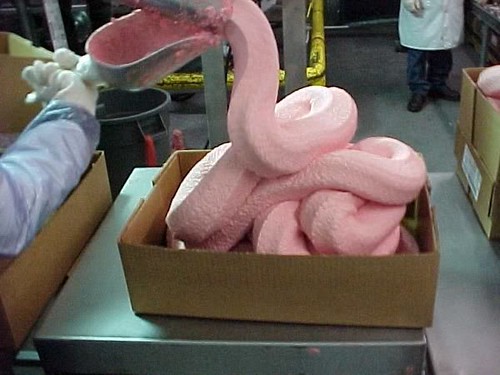Vegetarians Spreading Pink Chicken Lie
This photo went viral this weekend as Vegetarian Awareness Month kicked off. It shows a closely cropped photo of a pink material extruded from some type of machine being dumped into a cardboard box like a gigantic pink turd. The caption that goes with this picture is:
Say hello to mechanically separated chicken. It’s what all fast-food chicken is made from, things like chicken nuggets and patties. Also, the processed frozen chicken in the stores is made from it. Basically, the entire chicken is smashed and pressed through a sieve—bones, eyes, guts, and all. It comes out looking like this. There’s more: because it’s crawling with bacteria, it will be washed with ammonia, soaked in it, actually. Then, because it tastes gross, it will be reflavored artificially. Then, because it is weirdly pink, it will be dyed with artificial color. But hey, at least it tastes good, right?
Of course it sounds disgusting if it were even partially true. But everything in that paragraph is an outright lie.
First lie is that this is mechanically separated chicken. It doesn’t look like this at all. It is a grayish-pinkish material that still looks like lumps of meat while the inedible bone is discarded as waste. And you don’t put it into a cardboard box. Empty cardboard is covered in little paper slivers and that would contaminate the food.
Second lie is that whole chickens are processed through one of these. Wrong. The white meat and most of the dark meat is picked off first because people pay good money to eat good chicken. Only the meat that clings to the bones are processed mechanically.
Third lie is that all fast food chicken is made from this. Wrong. Most fast food uses whole chicken parts, especially places like McDonalds, Burger King and KFC.
Next lie is that the meat is soaked in ammonia. Yeah, thats against the law for any food that is made for animal or human consumption. Real mechanically separated chicken is processed under strict sanitary conditions and immediately frozen.
And there is no need to add artificial flavorings, although I’m certain a lot of salt gets added.
I don’t know what is shown in this picture, but its not food. The intent was to clearly frighten people into being vegetarians. If Vegans can’t convince people with logic and reason to join their stupid movement they have to rely on shock and outright lies to do it. And people who think its cruel to kill animals for food sure don’t have any qualms about not wanting to use the whole animal. Wouldn’t using the whole animal be more humane if it has to die?
Here is a great video showing the real behind the scenes processes of how McDonalds gets their food from the manufacturer.
Thanks again to Ed of Right Rant.


Interesting that the video made no reference whatsoever to how McDonald’s chicken products are processed, which is the issue of the original “pink chicken” photo. The video only addresses meat patties, sausage, & biscuits.
Interesting that you probably believe what the unclean and unhealthy vegans posted…
McDonalds uses whole white meat chicken. Its fried in a tempura batter, frozen and shipped. Its not a mystery. The only real mystery is what this pink stuff is because it certainly is not food.
It’s Vegans… Kinda like Soylent Green… Only before the color additive.
Read more about “pink slime” here: http://www.grist.org/article/2010-07-30-ask-umbra-on-pink-slime-in-hamburger-meat/
I’m a USDA?FSIS Public Health Veterinarian. This stuff is, most likely, mechanically separated poultry. It’s about the right color (the stuff I’m used to seeing looks more like orange sherbet) and consistency. The cardboard box is most likely wax-coated if the stuff is to be used in people food, less likely if it is destined for animal food. The mechanically separated poultry does end up in many products, but not in things that have actual meat fibers (like a chicken strip, etc) The separation is completed in a machine usually called a ‘beehive’ or ‘badder’ and the meat goes one way and the bones go another. There is nothing inherently wrong with the product although in it’s present form it is a little unpalatable. It looks better once it’s turned into sausages. The only time whole carcasses are used are when they are from ‘spent laying hens’ which don’t have much meat on them to begin with. Usually, like you said, picked carcasses are sent for mechanical separation. It’s a perfectly viable source of protein if you’re a carnivore, like me.
Thanks Doc.
From the machines I’ve seen online, there are actually two extrusions. The first is a solid material and the other is the liquefied goop. But the solid does not look this thick. That this photo was so closely cropped makes me suspicious that this is not what it described. What about the claim that the meat is soaked in ammonia?
Ammonia? Not that I’ve ever seen. It is POSSIBLE that some manufacturers using MSP may use Ammonium Chloride as a food additive, but I doubt it. I don’t believe it can be used as such in the USA. Plants CAN, however, make food destined for other countries. Ammonium Chloride is VERY far from actual Ammonia! The only thing remotely involving ammonia is that most refrigeration systems in large packing plants use ammonia as their ‘freon’. The meat sherbet (as I call it) is usually either packed in one-ton ‘combos’ (Large, plastic lined reinforced cardboard containers about 4x4x4 foot) or frozen in 40 pound containers, like that one in the video. The solid material in the videos is most likely beef or pork. It is not called “mechanically separated” but instead it is called ‘AMR’ for advanced meat recovery, made using water jets on meaty bones instead of a centrifuge on ground-up picked bird carcasses. It separates only MEAT (skeletal muscle) and does not include bone marrow, etc, as does MSP. This is because of what is known as specified risk material or SRM, including nerve ganglia, spinal cord, etc, being included in mechanically separated meats. Chickens have no SRM’s. This material can NOT enter the human food chain due to the incredibly minicule chance of Bovine Spongiform Encephalopathy or ‘mad cow’ being contained in these SRMs. Although pork does not contain the BSE prion or (at least as far as we know) anything even like the BSE prion, the regulations only distinguish ‘poultry’ (chicken, turkey, duck, etc.) from ‘red meat'(beef, pork, lamb, goat, etc). Oh, BTW, in the above post that should have been USDA/FSIS Veterinarian, not USDA?FSIS. FSIS stands for Food Safety Inspection Service. Your tax dollars at work!
Thanks again, Doc.
I’m actually working with USDA/FSIS on cyber security issues and I become fascinated at how you guys do business. Especially the foreign aspects of your business as you help other countries become self sustainable.
Hey so what led you to my blog? (too lazy to check the logs to determine the source of your redirection) Did you also see this pic and run a google search on how true it was? Did your instincts about this issue make you question the validity as it did mine?
IIRC, I was sent here via a link back in May or June. The first thing I remember seeing was the “I understand Twilight” video. I just began reading the blog after that. It is refreshing to come upon someone who is conservative but not, well, assholish about it. The liberal whackjobs spew more hate and vitriol than any conservative, in my opinion. But no, I didn’t Google their ‘research’. I know BS when I hear it… 8^)
The beef products which include high levels of ammonia are not mythical. They are a beef filler product made by Beef Products International from the remainders when normal processing uses all the beef products originally usable.
This part is not in any way some vegetarian myth.
Beef Products Incorporated is quite proud of their work, and emphasize the role of ammonia in killing any e-coli present in the product. They even go on to speak positively about the role of ammonia in all life.
Whether or not one is skeptical about BPI’s claims of healthfulness of their products or subjectively pleased or disgusted with its widespread use, it’s simply fantasy to dismiss this real fact.
The video, however, is completely irrelevant, as it focuses on the McDonald’s side of the use of beef, and not the components of the beef which it buys.
It is true that such products are not used in the case of whole meat strips used, such as chicken filets etc. or strips of beef like in fajitas etc. I have not encountered specific claims that BPI-like products are used in poultry or pork products which are not whole meat pieces (i.e., sausage).
However, there are clearly market incentives for doing so, and the inclusion of BPI’s beef-remainder / ammonia-mixed products do not appear to be significantly affecting sales, so I see no reason why such similar products would not be used for ground or processed chicken or pork products.